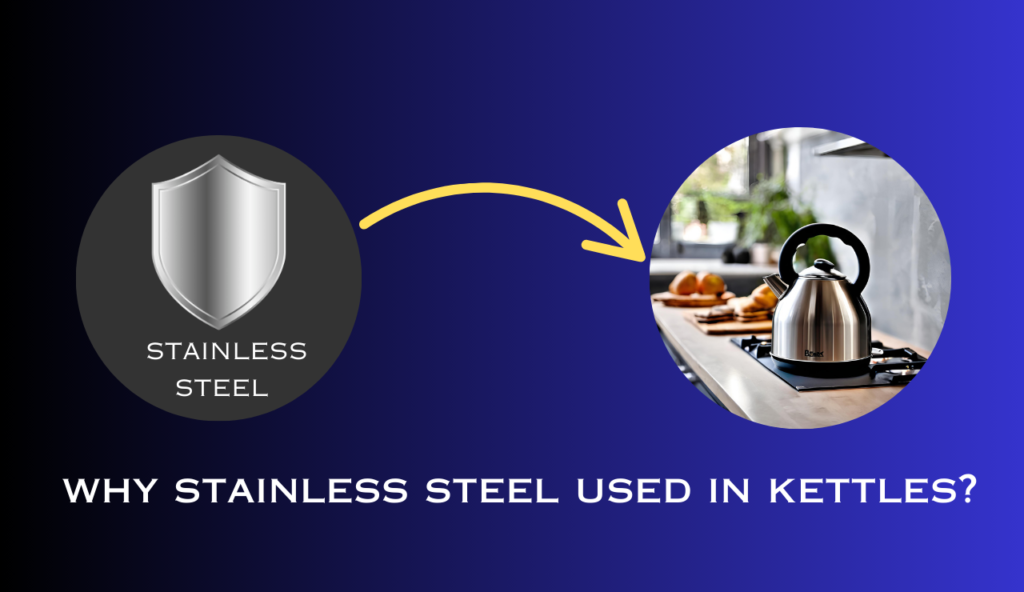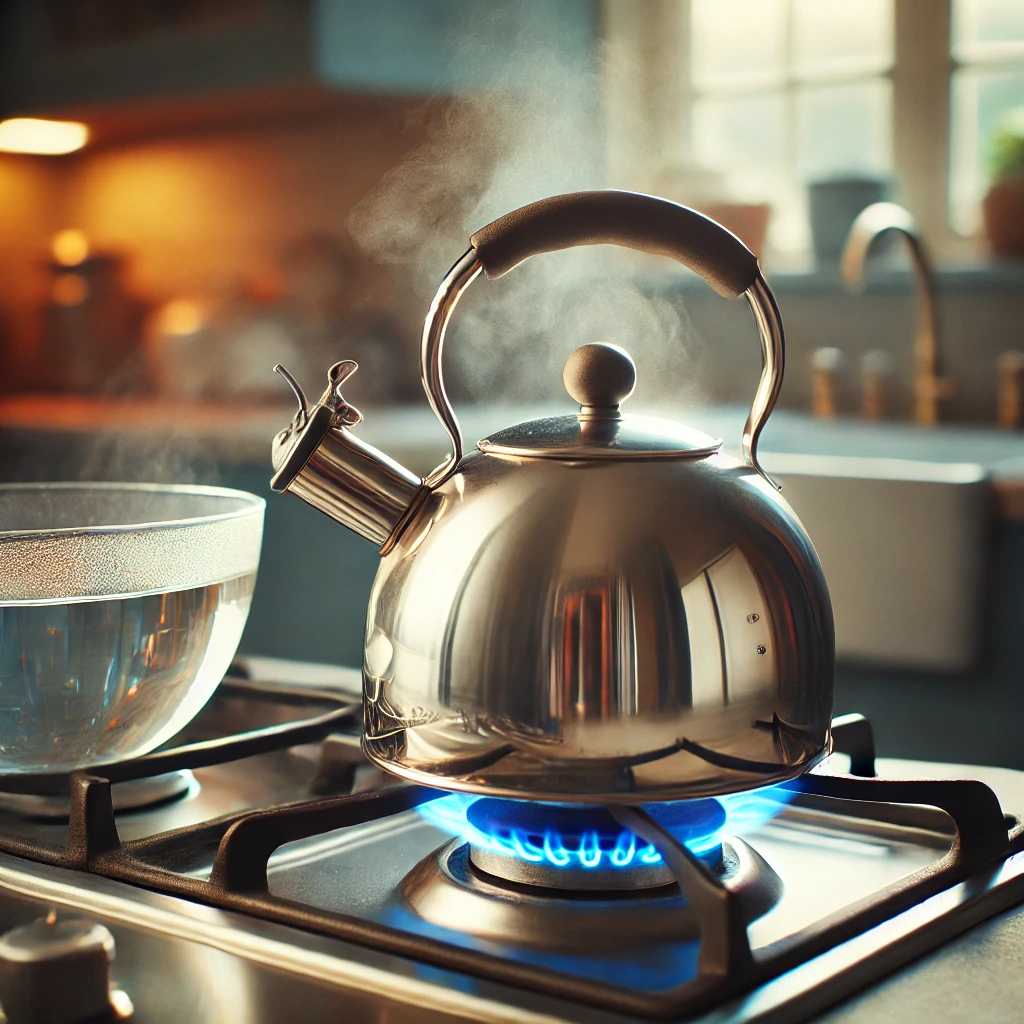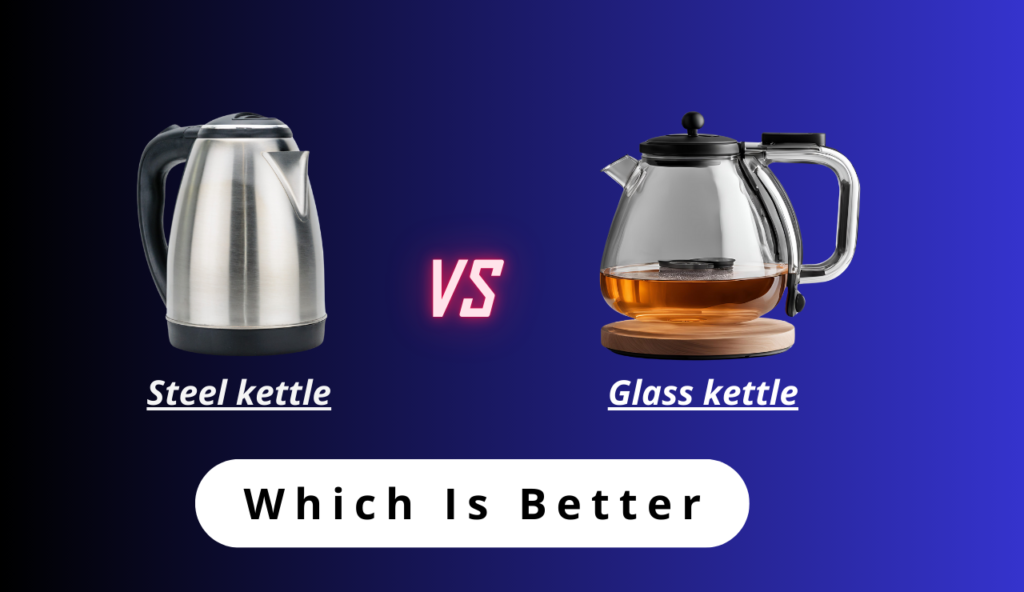Ever wondered if your daily cup of tea or coffee from a stainless steel kettle is truly safe? With so many kitchen products claiming to be “100% safe,” it’s easy to overlook potential risks.You deserve peace of mind knowing your kettle isn’t secretly leaching harmful chemicals into your drink.
Table of Contents
Is stainless steel kettle safe for daily use?
Yes, stainless steel kettles are generally safe for boiling water and preparing drinks. To avoid metal leaching, make sure to use a high-quality kettle. Regular cleaning and maintenance additionally guarantee their safety and efficiency.
In this post, we’ll break down the facts, clear up the myths, and help you make an informed choice about your stainless steel kettle.
What is Stainless Steel and Why is it Used in Kettles?

When we talk about kettles, stainless steel is one of the most common materials you’ll find. But what exactly is stainless steel, and why do we trust it for something as important as boiling water? Let’s break it down.
Definition of Stainless Steel: What Makes it ‘Stainless’?
Stainless steel is a special type of metal that doesn’t rust or stain easily. It’s made by mixing iron with a bit of chromium. The chromium creates a protective layer on the surface, which prevents rust and corrosion. This makes your stainless steel kettle safe and durable, even after years of daily use.
Food-Grade Stainless Steel Explained
How all stainless steel is made equal, particularly in terms of food safety. The two most common types used in kettles are 304 (18/8) and 316 stainless steel. These numbers might sound technical, but they simply tell us how much chromium and nickel the steel contains. Both types are considered food-grade, meaning they are safe for boiling water and won’t react with your drinks.
Non-Reactivity of Stainless Steel
One of the best things about stainless steel is that it doesn’t react with water, even when it’s boiling hot. Unlike some other metals, it won’t leach harmful chemicals into your tea or coffee. This is one big reason why your stainless steel kettle is safe for everyday use.
Thermal Properties of Stainless Steel
Stainless steel is a good heat conductor, so it heats quickly and efficiently. Which means it heats up quickly and evenly. It also retains heat well, so your water stays warm for longer. This makes our stainless steel kettles energy-efficient and convenient.
Sustainability: Is Stainless Steel Environmentally Friendly?
Good news — stainless steel is recyclable! When your kettle reaches the end of its life, the material can be reused, reducing waste and helping the planet.
In short, your stainless steel kettle is safe, reliable, and environmentally friendly. It’s no wonder they’re a favorite in so many kitchens!
Is It Safe to Drink Water Boiled in a Stainless Steel Kettle?

When it comes to boiling water, stainless steel kettles are a popular choice. But the big question is: Is your stainless kettle safe for everyday use? Let’s break it down in simple terms.
Non-Toxic Nature of Stainless Steel
Stainless steel is known for being non-reactive, which means it doesn’t release harmful chemicals into your water. This is one reason why my stainless kettle is safe for daily boiling. Food-grade stainless steel, like 304 or 316, is specifically designed to handle heat without breaking down or reacting with water.
Risk of Metal Leaching Under Certain Conditions
While stainless steel is generally safe, poor-quality or damaged kettles can sometimes release tiny amounts of nickel or chromium into the water. This usually happens if the kettle is scratched, rusted, or made from low-grade steel. That’s why it’s important to make sure your stainless kettle is safe by choosing high-quality, food-grade stainless steel and checking it regularly for damage.
Scientific Studies and Research Evidence
Research shows that food-grade stainless steel is one of the safest materials for boiling water. Studies have found that stainless steel kettles, when used properly, do not leach harmful chemicals into water, even at high temperatures. This scientific backing is why millions of homes trust stainless steel kettles.
How to Identify Food-Grade Stainless Steel Kettles?
To ensure our stainless kettle is safe, look for certifications like FDA approval or labels indicating 304 (18/8) or 316 stainless steel. These numbers guarantee that the kettle is made from food-safe materials.
Proper Usage Tips for Long-Term Safety
- Avoid overboiling water in your kettle.
- Cleaning your kettle on a regular basis will help to avoid mineral accumulation of bacteria.
- Check for scratches, rust, or damage, and replace the kettle if needed.
In short, a stainless kettle is safe if it’s made from food-grade materials and properly maintained. So go ahead, boil that water, and enjoy your next cup of tea worry-free!
↘️↘️↘️
Did You know plastic kettles are safe or not ? then check this blog 👉👉👉Is a plastic kettle safe ?Is It Bad to Leave Water in a Stainless-Steel Kettle?
You might wonder, “Is it okay to leave water sitting in my stainless steel kettle?” While a stainless kettle is safe, leaving water in it for too long isn’t the best idea. Here’s why:
Effects of Prolonged Water Storage in Kettles
When water sits in your kettle for too long, minerals like calcium and magnesium can settle at the bottom. Over time, these form limescale—those white, chalky deposits. Plus, stagnant water can become a breeding ground for bacteria, especially if your kettle isn’t cleaned regularly.
Corrosion Risk Over Time
Good-quality stainless steel resists rust, but poor-grade steel can react with stagnant water. This reaction might slowly damage the inner surface of your kettle, reducing its lifespan.
Impact on Taste and Odor
Ever noticed a metallic or stale taste in your water after it’s been sitting? That’s because stagnant water can absorb flavors from the kettle’s material. Even in a stainless steel kettle, water can lose its freshness if left too long.
Best Practices
To keep your kettle in top shape:
- Always empty it after each use.
- Dry it thoroughly to prevent water from sitting and causing buildup.
Descaling Solutions
If you notice limescale forming, don’t worry! You can clean your kettle naturally:
- Add a mixture of water and vinegar (or lemon juice).
- Boil it and let it sit for about 30 minutes.
- Rinse well with clean water.
By following these simple steps, you’ll keep your stainless kettle safe and your water fresh every time!
↘️↘️↘️↘️
Did you know metal kettles are safe or not ? then check this blog 👉👉👉 Are metal kettles safe ?Which is best?- Glass Kettle or Stainless Steel Kettle

Choosing between a glass kettle and a stainless steel kettle can be tricky. Both have their pros and cons, so let’s break it down to help you decide what fits your needs best.
Durability
A stainless steel kettle is safe and built to last. It can handle drops, bumps, and scratches without much damage. On the other hand, glass kettles look elegant but are fragile and can crack or shatter if dropped.
Safety
When it comes to safety, stainless steel is non-reactive and holds heat well. But if the steel is of poor quality, there’s a small chance it might leach metals into the water.
Glass kettles, however, are completely inert, meaning they won’t react with water. But they’re sensitive to sudden temperature changes, which can cause them to crack.
Heat Retention
If you want water to stay hot for longer, stainless steel kettles win. They have excellent heat retention. Glass kettles, while beautiful, lose heat much faster.
Maintenance
Stainless kettles can develop limescale buildup over time, which means regular cleaning is a must. Glass kettles make it easy to see any residue buildup, but scrubbing off those deposits can be more challenging.
Aesthetic Appeal
If you care about looks, glass kettles are clear winners. You can see the water boiling and check its clarity. However, a stainless kettle has a modern and professional appearance that fits in almost any kitchen.
Conclusion
So, what’s your priority? If you want durability and heat retention, go for a stainless steel kettle. But if you love aesthetics and transparency, a glass kettle might be the perfect choice for your kitchen.
Can I Put Hot Water in a Stainless Steel Kettle?
Yes, you can pour hot water into a stainless steel kettle—it’s generally safe. Stainless steel is known for its durability and resistance to heat, so your kettle can handle hot water without major issues.
Thermal Expansion in Stainless Steel
When hot water is poured into your stainless kettle, the metal slightly expands due to heat. However, high-quality stainless steel is built to handle this thermal expansion without cracking or bending.
Is There a Risk of Damage?
If your kettle is well-made, there’s little risk of warping or damage. But poor-quality kettles might not handle repeated thermal shocks well, causing small cracks or structural weakness over time.
Impact on Taste or Safety
Stainless steel doesn’t react with hot water, so it won’t affect the taste or safety of your water. This is one reason why stainless steel is a popular material for kettles.
Precautions to Take
Make sure your kettle is designed for high heat and quick temperature changes.Always read the manufacturer’s instructions before using.
When to Avoid It?
Avoid pouring hot water into your kettle if it looks flimsy or shows signs of damage like dents or cracks. In such cases, it’s better to replace it for your safety.
Is Stainless Steel Immune to Water?
Stainless steel is known for being rust-resistant, but is it completely immune to water? Not exactly. While your stainless kettle is safe for everyday use, certain conditions can still cause it to rust.
Understanding Stainless Steel’s Resistance to Corrosion
Stainless steel contains chromium, which creates a thin protective layer known as chromium oxide. This layer keeps water and oxygen from reaching the metal underneath, preventing rust.
Can Stainless Steel Rust?
Yes, it can—especially if it’s exposed to saltwater, harsh chemicals, or isn’t cleaned properly. Poor-quality stainless steel or a damaged kettle might also lose its rust resistance over time.
Passivation Layer Explained
The chromium oxide layer acts like a shield, keeping moisture and air away from the metal. If this layer gets scratched or worn out, rust can start to form.
Maintenance to Prevent Rusting
To keep your stainless kettle safe, clean it regularly and dry it thoroughly after each use. Avoid using harsh scrubbers that could damage the protective layer.
When Stainless Steel Fails?
If you notice rust spots, discoloration, or rough patches on your kettle, it might be time for a replacement. Always choose high-quality stainless steel for long-lasting performance.
Disadvantages of Stainless Steel Kettles
While a stainless kettle is safe and durable, it’s not perfect. Let’s look at some common downsides you should know about.
Potential Metallic Taste in Water
If your kettle is made from low-quality stainless steel, it might leave a slight metallic taste in the water. High-quality kettles usually avoid this problem, so it’s worth investing in a good one.
Risk of Overheating
Stainless steel conducts heat really well, which means the body of your kettle can get extremely hot. If you’re not careful, you could accidentally burn your hand while touching it.
Weight
Compared to glass or plastic kettles, stainless steel kettles are heavier. This might make them harder to handle, especially when they’re full of water.
Limescale Buildup
Over time, minerals from water can build up inside your kettle as limescale. This can affect its performance and even the taste of your water. Regular descaling is a must.
Cost
A high-quality stainless kettle is safe and long-lasting, but it can also be expensive. Cheaper options may not offer the same durability or safety.
Environmental Concerns
The manufacturing process of stainless steel is energy-intensive, which raises environmental concerns. However, stainless steel is recyclable, which helps balance its impact.

